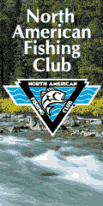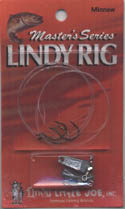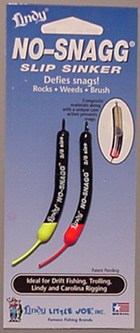
Free 90 day Risk free trial offer click
here





















|
Late Season Lindy Rigging
By Sam Anderson
Walleyes love live bait, especially in the fall, and there's no more
practical way to present live bait than behind a Lindy Rig slowly dragged
along the bottom. Lindy rigging, allows an angler to comb a lot of
water quickly. It's a great way to search for walleye schools that
are scattered along a drop-off.
 Orignal
Lindy rig
Orignal
Lindy rig
|
The key to Lindy rigging is a slow, meticulous presentation.
A sluggish walleye is more apt to grab a small fathead or leech than a
big golden shiner or nightcrawler. Don’t stubbornly stick with jumbo
leeches or nightcrawlers just because they’ve produced in the past.
Try some Thill Floats with a light jig or some slow backtrolling of jigs.
The key here again is slow down. If you think you are slow now
slow down even further and watch your line, because if your presentation
is in slow motion your action will be fast. Try a stinger hook. Sluggish
walleyes have a habit of striking short and ripping up the tail of a minnow
or snipping the end off a crawler |
By attaching a small treble or single hook to the bend and then inserting
one hook of the treble into the tail of your bait, you can hook many of
the short striking fish. This technique is deadly with a jig and
crawler or a jig and minnow. When those walleyes get lockjaw because of
cold weather or they have been on a feeding frenzy I suggest hitting them
in the nose. The analogy that I use is this: If you have just finished
a very large meal like your Thanksgiving dinner and you sit down to watch
a little TV, how hungry are you for something sweet? What happens
when someone puts a box of chocolates on top of the TV? Will
you get up from the couch and select one of them to top off your meal?
What happens when the chocolates are set right in front of you? Moral
of the story, a smart walleye always keeps his mouth shut. Or could
it be, that when presented with an easy tidbit, even tight lipped walleyes
can't resist.
 |
Terminal tackle for a live bait rig usually includes a walking sinker
threaded onto the line on top of a barrel swivel . Keep the sinker
weight as light as possible, yet heavy enough to let you feel the weight
along the bottom. Usually 1/4 to 1/2 ounce sinkers should be
adequate for late-season fishing. I prefer to use the No-Snagg weights
in the fall. The No-Snagg is a banana shaped sinker that has a balsa, lead
antimony weight that is surrounded by epoxy paint and a protective clear
seal coating, with a special rubberized coating on the outside. The
sinker also has a stainless steel wire feeler out of the bottom that
is tipped with a colored bead. This has the super principles of the
3-way and the bottom ticking ability of the bottom bouncer. Also,
the
No-Snagg when it hits an obstruction simply pivots away from the snag
and doesn’t get hung up. |
From the opposite end of the swivel run a 2 to 4 foot snell of 6 to 8 pound
test monofilament. Adjust the distance of your live-bait rig from
the bottom according to water clarity. In stained water the fish
will be tight to the bottom so the rig should run closer to the bottom.
Just the opposite frequently holds true in clear water. I prefer to use
the Lindy Rig in this case because it allows me the versatility of
getting the live bait right in the face of suspended walleyes. A
plain hook, or a colored hook are great, usually number 6 or number 8 finishes
off the rig except for the bait. Let the fish show you which form of live
bait to use. A general rule of thumb is to use smaller minnows in
the spring and larger minnows in the fall, with leeches and nightcrawlers
being most productive in the warmer months of summer. However, I've
found that walleyes don't always adhere to the rules. I like to have
a complete selection of bait in the
boat with me whenever I go fishing. Walleyes often take minnows lightly,
and will sometimes nibble at the tail of the night crawler like a small
perch does. These slow biters have to be given time to get the bait
into their mouths so that the hook can do its job.
 
Thill
Center slider float |
That's the reason for the Thill Float, it allows you to feed line to
the fish. Most anglers use open-face spinning reels for live bait
rigging. They backtroll, with the bail open and the line caught under
the index finger of their rod hand. When they feel a bite, they simultaneously
point the rod tip back toward the fish and straighten
their finger, allowing line to run freely off the spool. After
anywhere from 3 to 30 seconds depending on how aggressive the fish are
they reel up the slack line quickly until they feel the weight of the fish. |
They then snap the rod back with authority and hoist another walleye into
the
boat. As much as I like to eat walleyes, I like to catch them even
more. Walleyes are susceptible to a variety of lure presentations.
They'll take jigs, crankbaits, in-line spinners, and plastic baits.
But when the walleyes turn fussy, there's nothing I like better than a
Lindy live-bait rig. Lindy rigs will take walleyes when nothing else
will, and they're easy to use. If you have other tips you would like
to share with me you can drop me a line on the web at
www.samanderson.com.

Walleyes Inc. website is maintained
by Randy
Tyler Fishing the In-Fisherman Professional Walleye Circuit, Masters
Walleye Circuit and the Team Walleye Circuit. All rights reserved.Copyright
1999/2001
Please visit these site sponsors
Daiichi/Tru-Turn Hooks,
Lindy
Little Joe,
R-A.M Mounting Systems,
Ranger
boats, Mercury Marine, Bedford
Sales , Hamby's Beaching Bumpers,
Goldeneye
Marine products, Panther
Marine Products, Webfoots body
sock, Bait Rigs Tackle
|






